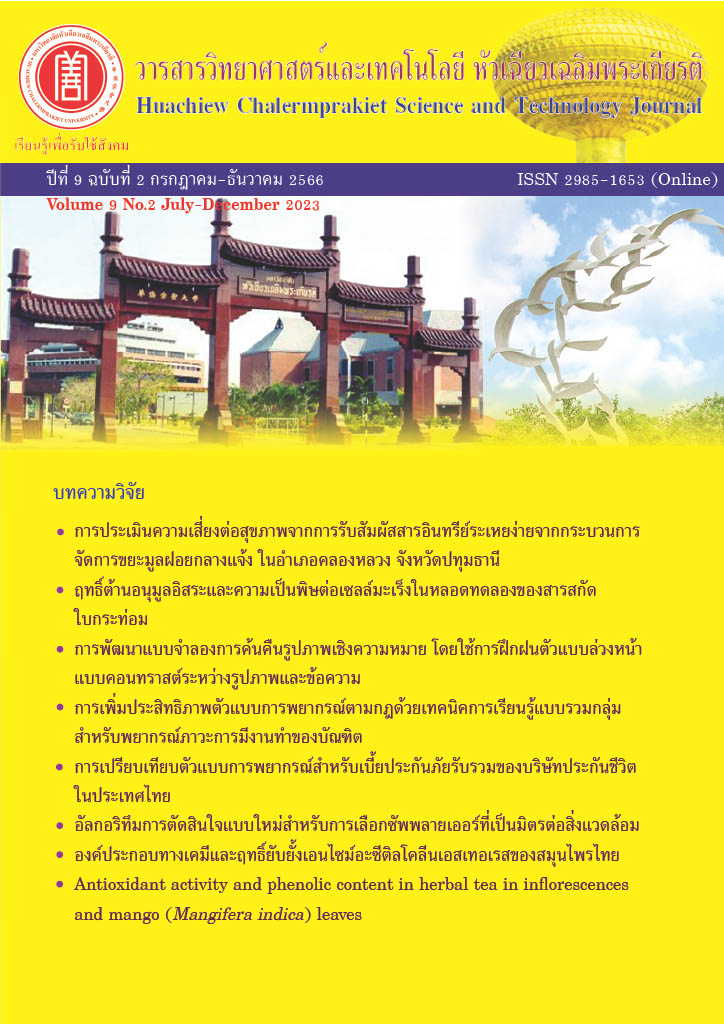Antioxidant Activity and Phenolic Content in Herbal Tea in Inflorescences and Mango (Mangifera indica) Leaves
คำสำคัญ:
Antioxidant activity, Phenol, Mango inflorescence, Mango leaves, Herbal teaบทคัดย่อ
The mango (Mangifera indica) fruit is an economic fruit. Thailand is the third-largest mango exporter after the Philippines and Mexico. Mango leaves are reported to have anti-inflammatory properties, blood sugar lowering effect, and blood lipid-lowering effect. Mango leaves are generally not being interested much and considered waste in agriculture despite their medicinal properties. To create a herbal tea for health enhancement extracts from mango leaves and inflorescences were examined in this study. The investigation of the antioxidant properties of crude mango inflorescence and leaf extracts was determined to examine the antioxidant activities of crude extracts, two tests were performed: 1) scavenging capacity, such as the ability to eliminate or suppress free radicals, as measured by the DPPH method, and 2) the ability to function as an electron donor or what is called a “reducing agent”. The FRAP test revealed that tea made from Man Duan Kao mango leaves had the highest anti-oxidant activity (53.65 0.70 g FeSO4/100 g tea powder), and it was discovered that mango inflorescences deliver more antioxidants than leaves (57.60 1.49 g FeSO4/100 g tea powder). The total phenolic and flavonoid contents of the crude extracts of tea from mango inflorescences and leaves revealed that tea from Mangifera indica leaves tended to have a higher total phenolic content. The largest levels of catechins and flavonoids were identified in both green and oolong tea, while mango inflorescence tended to provide overall phenolic content and more flavonoids than leaves, which results in consistent outcomes. Colorimetric examination (CIE-Lab) showed no variation in b*, C*, and h values, except an increase in illuminance (L*) values for samples cured for shorter treatment durations inversely related to the value of redness (a*) in samples undergoing a lengthy preparation procedure.
เอกสารอ้างอิง
Suphan Buri Provincial Agriculture and Cooperatives Office. Basic information in agriculture and cooperatives of Suphan Buri Province [Internet]. 2020 [cited 2023 May 1]. Available from: https://www.opsmoac.go.th/suphanburi-dwl-files-421191791138 (In Thai)
Patarakijavanich P, Sato VH, Kongkiatpaiboon S, Chewchinda S. A review of the antidiabetic potential of Mangifera indica leaf extract. Songklanakarin J Sci Technol 2019;41(4):942-50.
Lim TK. Edible medicinal and non-medicinal plants, volume 1, fruits. Dordrecht: Springer Science and Business Media; 2012.
Bally SE. Mangifera indica (mango) Anacardiaceae (Cashew family). Honolulu: Permanent Agriculture Resources; 2006.
Masud Parvez GM. Pharmacological activities of mango (Mangifera indica): a review. J pharmacogn phytochem 2016;5(3):1-7.
Majumdar PK, Sharma DK. Mango: Fruits of India: Tropical and subtropical. 1st ed. Kolkata: Naya Prokash; 1985.
Jiangsu X. Dictionary of traditional Chinese medicines. Shanghai: Shanghai Scientific and Technologic Press; 1977.
Wong W. Some folk medicinal plants from Trinidad. Econ Bot 1976;30:103-42.
Barreto JC, Trevisan MT, Hull WE, Erben G, de Brito ES, Pfundstein B, Owen RW. Characterization and quantitation of polyphenolic compounds in bark, kernel, leaves, and peel of mango (Mangifera indica L.). J Agric Food Chem 2008;56(14):5599-610.
Dineshkumar B, Mitra A, Manjunatha M. Studies on the anti-diabetic and hypolipidemic potentials of mangiferin (xanthone glucoside) in streptozotocin-induced type 1 and type 2 diabetic model rats. Int j adv pharm sci 2010;1:75-85.
Ediriweera MK, Tennekoon KH, Samarakoon SR. A review on ethnopharmacological applications, pharmacological activities, and bioactive compounds of Mangifera indica (Mango). Evidence-Based Complementary and Alternative Medicine [Internet]. 2017 [cited 2023 May 6]. Available from: https://doi.org/10.1155/2017/6949835
Tea and Coffee Institute of Mae Fah Luang University. Tea Processing [Internet]. 2022 [cited 2022 May 6]. Available from: https://teacoffee.mfu.ac.th/tc-tea-coffeeknowledge/tc-tea/tc-teaproductionprocess.html (In Thai)
Xie ZJ, Huang JR, Xu XM, Jin ZY. Antioxidant activity of peptides isolated from alfalfa leaf protein hydrolysate. Food Chem 2008;111(2):370–6.
Tang C, Sun J, Liu J, Jin C, Wu X, Zhang X, et al. Immune-enhancing effects of polysaccharides from purple sweet potato. Int J Biol Macromol 2019;123:923-30.
Hamrouni-Sellami I, Rahai F, Bourgou S, Limam F, Marzouk B. Total Phenolics, Flavonoids, and Antioxidant Activity of Sage (Salvia officinalis L.) Plants as Affected by Different Drying Methods. Food Bioproc Tech 2013;6(3):806–17.
Mandal P, Ghosal M. Antioxidant activity of three cultivars of Mangifera indica L. International Conference and Exhibition on Food Processing & Technology [Internet]. 2012 [cited 2023 December 2]. Available from: https://www.walshmedicalmedia.com/conference-abstracts-files/2157-7110_S1.002_007.pdf
Wu CH, Huang SM, Lin JA, Yen GC. Inhibition of advanced glycation endproduct formation by foodstuffs. Food Funct 2011;2(5):224-34.
Mao JT, Xue B, Smoake J, Lu QY, Park H. MicroRNA-19a/b mediates grape seed procyanidin extract-induced anti-neoplastic effects against lung cancer. J Nutr Biochem 2016;34:118-25.
Yuan H, Zhu X, Wang W, Meng L, Chen D, Zhang C. Hypoglycemic and anti-inflammatory effects of seabuckthorn seed protein in diabetic ICR mice. Food Funct 2016;7(3):1610-5.
ดาวน์โหลด
เผยแพร่แล้ว
รูปแบบการอ้างอิง
ฉบับ
ประเภทบทความ
สัญญาอนุญาต
ลิขสิทธิ์ (c) 2023 วารสารวิทยาศาสตร์และเทคโนโลยี หัวเฉียวเฉลิมพระเกียรติ

อนุญาตภายใต้เงื่อนไข Creative Commons Attribution-NonCommercial-NoDerivatives 4.0 International License.
บทความทุกบทความที่ได้รับการตีพิมพ์ถือเป็นลิขสิทธิ์ของ คณะวิทยาศาสตร์และเทคโนโลยี มหาวิทยาลัยหัวเฉียวเฉลิมพระเกียรติ



